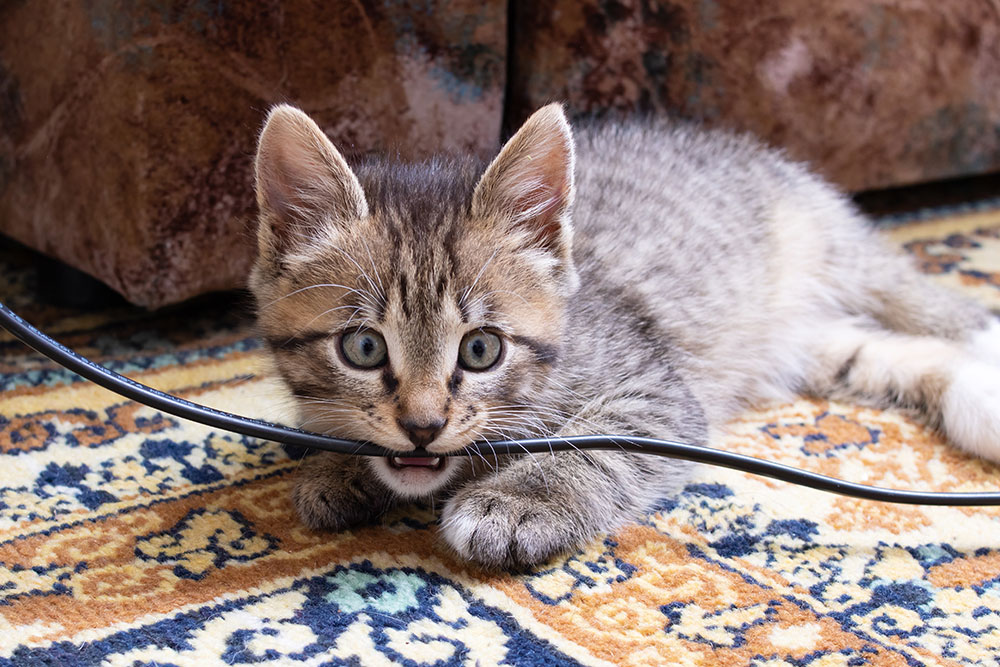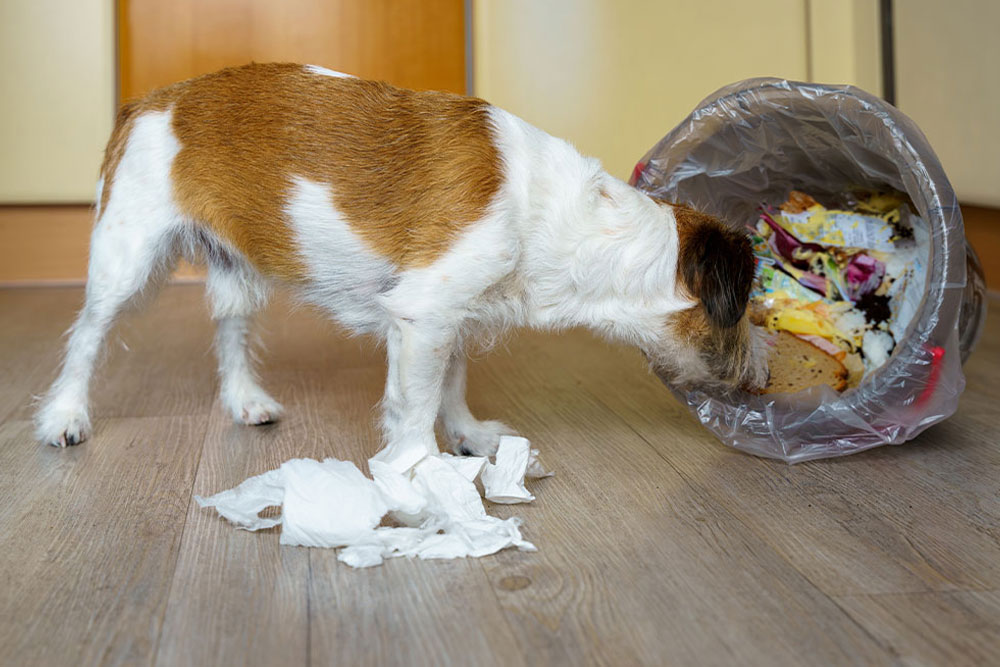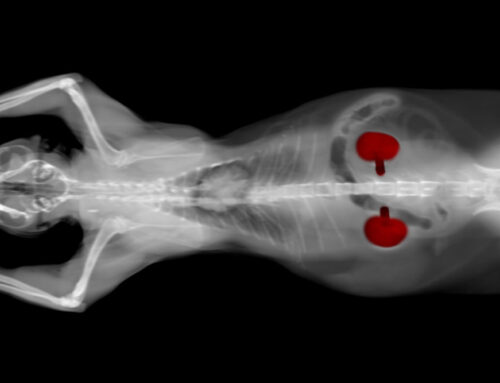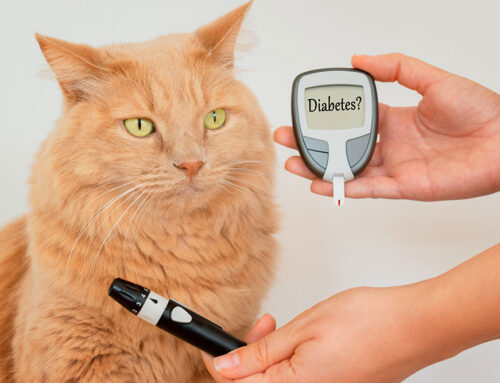If you’ve ever caught your pet chewing on something they shouldn’t—or worse, swallowing it—you’re not alone. Foreign object ingestion is one of the most common and potentially serious emergencies we treat at Greenfield Veterinary Clinic.
Whether it’s a sock, a skewer, or a squeaky toy, these incidents can lead to intestinal blockages, internal injuries, and even life-threatening infections if not treated promptly. Understanding what to watch for and when to act can make all the difference.
Why Pets Swallow Non-Food Objects
Dogs and cats explore the world with their mouths. Puppies and kittens are especially curious, but even adult pets can chew or ingest items out of boredom, stress, or sheer opportunity.
There are a few key reasons pets eat things they shouldn’t:
- Scent-driven curiosity: Items that smell like their favorite person—such as socks, underwear, hats, glasses, or even cell phones—are especially attractive. These carry the comforting scent of their owner, but they’re often swallowed before the pet realizes it’s not food.
- Household activity: Pets may grab things that other family members handle frequently—remotes, earbuds, watches, baby pacifiers, or children’s toys, especially if they’re soft or rubbery.
- Tempting textures or tastes: Trash, compost, food packaging, bones, skewers, foil, and string often retain the smell or flavor of food and are particularly risky. Pets can quickly pull these out of the garbage or off counters.
- Their own belongings: Chewed-up toys, loose bedding, chewed harnesses, or stuffing from pet beds can be accidentally ingested during play.
- Environmental appeal: Outdoors, pets may chew on mulch, soil, small rocks, or sticks—many of which can cause obstructions or be toxic.
High-Risk Items Frequently Ingested by Pets
These are some of the most common—and dangerous—objects we see in emergency cases:
- Socks, underwear, gloves
- Rubber balls, squeakers, toy stuffing
- Bones (especially cooked), toothpicks, string, yarn
- Plastic food wrappers, foil, and sandwich bags
- Batteries, coins, magnets, small electronics
- Feminine hygiene products or diapers
- Mulch, compost, rocks, and garden soil
- Jewelry, rings, hair ties, buttons, and pins
Items like batteries, magnets, and sharp skewers pose added risks due to potential chemical burns, perforations, or fatal blockages.
Symptoms of Foreign Object Ingestion
If your pet swallows something they shouldn’t, the signs may develop within hours—or may not show up for several days, depending on the object’s size, shape, and location in the GI tract.
Early symptoms may include:
- Repeated vomiting or retching
- Loss of appetite
- Lethargy or depression
- Drooling or lip-smacking
- Whining, restlessness, or hiding
- Abdominal pain (may tense or react when touched)
- Constipation or diarrhea
Severe or late-stage symptoms:
- Swollen or distended abdomen
- Fever or signs of systemic infection
- Labored breathing
- Dehydration
- Collapse or signs of sepsis
These signs often indicate intestinal perforation, peritonitis, or severe blockage—situations that require immediate surgical intervention.
What Happens If You Delay Care?
Delaying treatment can significantly worsen your pet’s outcome. A simple obstruction can quickly evolve into:
- Tissue necrosis: Pressure from the lodged object can cut off blood flow to intestinal tissue, causing it to die.
- Perforation and infection: Sharp objects can puncture the GI tract, releasing bacteria into the abdomen, leading to peritonitis or sepsis, both of which are life-threatening.
- Extended surgery and hospitalization: The longer the object remains inside, the more complicated and invasive the treatment becomes.
Early intervention often means faster, less invasive treatment—and a better chance at full recovery.
How Foreign Body Ingestion Is Diagnosed
Veterinary Evaluation
Your veterinarian will begin with a full history and physical exam. They may palpate the abdomen to check for tenderness, swelling, or abnormal masses.
Imaging and Diagnostics
- X-rays can help visualize many ingested objects, especially metal, bone, or dense plastic.
- Ultrasound provides more detail for soft or fabric items not visible on X-rays.
- Contrast studies may be used to track the flow through the GI system.
- Endoscopy can sometimes be used both to diagnose and remove the object without surgery.
Learn more about the process in this article on exploratory surgery in pets.
Treatment Options at Greenfield Veterinary Clinic
Non-Surgical Options
If the object was swallowed recently and hasn’t passed into the intestines, inducing vomiting (only under veterinary supervision) may be effective. For some stomach contents, endoscopic retrieval can remove the item without a surgical incision.
Surgical Intervention
For more advanced cases, abdominal surgery is required. This allows the veterinarian to remove the object directly and inspect for any damage to surrounding organs.
- Performed under general anesthesia
- Hospitalization for post-op monitoring
- IV fluids, antibiotics, and pain control provided
- Gradual reintroduction of food and normal activity
Recovery usually takes 7–14 days depending on the severity and the pet’s condition at the time of treatment.
Pet-Proofing Your Home: Practical Tips
The best way to prevent foreign body ingestion is to create a safe environment tailored to your pet’s habits.
Pet-Proofing Checklist:
- Store small objects, cords, and electronics out of reach—use drawer organizers or baby-proof latches.
- Keep laundry baskets and gym bags closed or off the floor.
- Empty trash cans frequently and use pet-proof lids.
- Supervise playtime with toys that have small parts or squeakers.
- Avoid giving cooked bones or food with skewers, foil, or string.
- Clean up dropped food items immediately, especially if children are eating in pet-accessible areas.
- Secure compost bins and garden tools when pets are outside.
For more strategies, visit AAHA’s guide to pet-proofing your home.

When to Call the Vet
Don’t wait for symptoms to worsen. Contact us immediately if:
- You witness your pet swallowing something unusual
- Your pet vomits repeatedly
- There’s no bowel movement or change in appetite for more than 24 hours
- You notice sudden lethargy or behavioral changes
- There’s visible discomfort or bloating
Delaying care only increases the risk of complications and the need for more extensive treatment. Call us now or visit our emergency page.
We’re Here to Help
At Greenfield Veterinary Clinic, we understand that emergencies can be scary. Our team is trained in emergency care and surgery, with diagnostic tools and experience to act quickly when every moment matters.
Need veterinary care? Contact Greenfield Veterinary Clinic now.







Leave A Comment